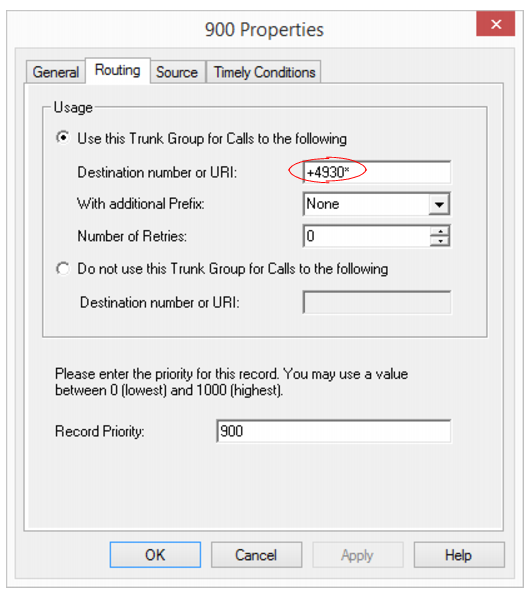Example 3
There is a SwyxWare installation with two SwyxServers, one in Berlin and one in England. The two SwyxServers are connected to each other over a SwyxLink.
In order that calls to England can in principle go via this SwyxLink, a routing record must be set up on the server in Berlin to forward all calls to England (prefix +44) via the SwyxLink to England.
Routing record in Berlin:
Allow call +44*; Trunk group "SwyxLink UK"; Priority 900
The user has the right at his Berlin location to telephone internally.
Entry in the user's call permission:
Deny call +*; Trunk group "All"
Allow call *; Trunk group "All"
But he has the right to phone England (prefix 44) via SwyxLink:
Entry in the user's call permission:
Allow call +44*; Trunk group "SwyxLink UK"
In England the SwyxLinkUK is configured in such a way that calls coming in via this trunk group have the right to initiate national calls via ISDN into the public network:
Entry in the call permission for SwyxLinkUK in England:
Allow call +44*; Trunk group "ISDN UK"
The user in Berlin is now able to call England via SwyxLink, and there to make calls into the entire national telephone network; but he cannot call locally in Berlin.
Such a constellation could e.g. make sense for a support employee, who only makes phone calls to the UK.
For private calls, a further permission can be set up with a public line access for private calls. e.g.
Entry in the user's call permission:
Allow call +4930*; Trunk group "ISDN Berlin"; Public line access 8 (private)
Call permission for SwyxLink trunk groups
SwyxLink trunk groups represent the connection between two SwyxWare installations. Every SwyxLink trunk is configured on both sides, on one side locally and on the other side remotely (
see chapter SIP Links).
A call that takes place over this connection inherits the call permission of the side on which it leaves this trunk; or, to put it another way, it receives the call permission of the trunk group which routes this call into SwyxWare.
Example:
There are two SwyxWare installations in Dortmund and Berlin, which are connected to a SwyxLink "Dortmund-Berlin".
The SwyxLink "Dortmund-Berlin" is managed locally in Dortmund and remotely in Berlin.
In Dortmund there is a call permission for the relevant trunk group, allowing only internal calls:
Entry in the call permission of SwyxLink "Dortmund-Berlin" in Dortmund:
Allow call *; Trunk group "All"
Deny call +*; Trunk group "All"
In Berlin a profile was set up for the assigned trunk group, allowing calls via ISDN into the local network in Berlin.
Entry in the call permission of SwyxLink "Dortmund-Berlin" in Berlin:
Allow call +4930*; Trunk group "ISDN Berlin"
If a user from Dortmund now calls Berlin via the SwyxLink "Dortmund-Berlin", his call can be forwarded there into the Berlin local network (call permission on the Berlin side!).
On the other hand, if a user from Berlin now calls Dortmund via the SwyxLink "Dortmund-Berlin", his call can only be forwarded to an internal employee, and not into the Dortmund local network (call permission on the Dortmund side!).



